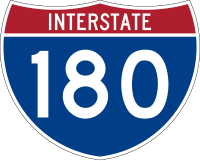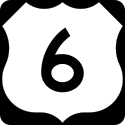Interstate 180 (Illinois)
| Basisdaten | |
|---|---|
| Länge: | 13,19 mi/21,23 km |
| Bundesstaat: | Illinois |
| Verlaufsrichtung: | Nord-Süd |
| Karte | |
 | |
Die Interstate 180 (kurz I-180) ist ein kurzer Zubringer, der die Interstate 80 bei Princeton mit den Illinois State Routes 26 und 71 nahe Hennepin auf einer Länge von 21,23 Kilometer (13,19 Meilen) verbindet.
Verlauf
Ab Hennepin verläuft die Interstate 180 zunächst in westlicher Richtung und überquert dabei den Illinois River. Nach der dem Kreuz mit der State Route 29 führt sie in Richtung Norden und passiert dabei die Ortschaft Bureau Junction. Nach einem Kreuz mit dem U.S. Highway 6 endet die I-180 an der Interstate 80.
History
Der Bau der I-180 wurde 1969 vollendet.[1] Sie wurde hauptsächlich gebaut um Interstate 80 mit einem neuen Jones & Laughlin Stahlwerk, das 1965 in Hennepin errichtet wurde, zu verbinden.[2] Jedoch würde das Stahlwerk kurz nach dem Bau von I-180 geschlossen und erst im August 2002 wieder eröffnet. I-180 ist eine der verkehrsärmsten Autobahnen der Nation, mit lediglich 1950–3600 Fahrzeuge täglich im Jahr 2013.[3]
Einzelnachweise
- ↑ Scott, Tony: Strong opinions on Prairie Parkway plans (englisch), Oswego Ledger-Sentinel. 21. Dezember 2006. Abgerufen am 15. Februar 2008.
- ↑ Boom Town 1965 (englisch). In: Time, 9. Juli 1965. Abgerufen am 9. Juli 2012.
- ↑ Illinois Department of Transportation: T2 GIS Data. 2013. Archiviert vom Original am 2. März 2016. Info: Der Archivlink wurde automatisch eingesetzt und noch nicht geprüft. Bitte prüfe Original- und Archivlink gemäß Anleitung und entferne dann diesen Hinweis. Abgerufen am 24. Februar 2016.
Weblinks
- Illinois Highway Ends (englisch)
- Interstate Guide (englisch)
- Roads of the Mid-South and West (englisch)
Auf dieser Seite verwendete Medien
Wellenlinie als Gewässersymbol für die Formatvorlage Autobahn
24 in by 24 in (600 mm by 600 mm) Illinois Route shield, made to the specifications of the sign detail (sign M-I100). Uses the Roadgeek 2005 fonts. (United States law does not permit the copyrighting of typeface designs, and the fonts are meant to be copies of a U.S. Government-produced work anyway.) The outside border has a width of 1 (1/16 in) and a color of black so it shows up; in reality, signs have no outside border.
24 in by 24 in (600 mm by 600 mm) Illinois Route shield, made to the specifications of the sign detail (sign M-I100). Uses the Roadgeek 2005 fonts. (United States law does not permit the copyrighting of typeface designs, and the fonts are meant to be copies of a U.S. Government-produced work anyway.) The outside border has a width of 1 (1/16 in) and a color of black so it shows up; in reality, signs have no outside border.
24 in by 24 in (600 mm by 600 mm) Illinois Route shield, made to the specifications of the sign detail (sign M-I100). Uses the Roadgeek 2005 fonts. (United States law does not permit the copyrighting of typeface designs, and the fonts are meant to be copies of a U.S. Government-produced work anyway.) The outside border has a width of 1 (1/16 in) and a color of black so it shows up; in reality, signs have no outside border.
600 mm by 600 mm (24 in by 24 in) Interstate shield, made to the specifications of the 2004 edition of Standard Highway Signs (sign M1-1). Uses the Roadgeek 2005 fonts. (United States law does not permit the copyrighting of typeface designs, and the fonts are meant to be copies of a U.S. Government-produced work anyway.) Colors are from [1] (Pantone Red 187 and Blue 294), converted to RGB by [2]. The outside border has a width of 1 (1 mm) and a color of black so it shows up; in reality, signs have no outside border.
600 mm × 600 mm (24 in × 24 in) U.S. Highway shield, made to the specifications of the 2004 edition of Standard Highway Signs. (Note that there is a missing "J" label on the left side of the diagram.) Uses the Roadgeek 2005 fonts. (United States law does not permit the copyrighting of typeface designs, and the fonts are meant to be copies of a U.S. Government-produced work anyway.)












